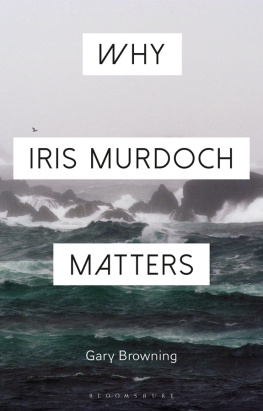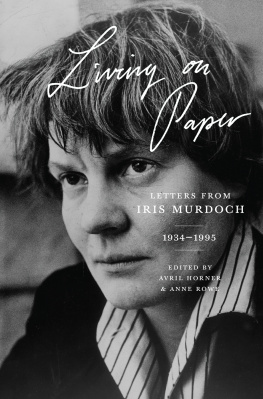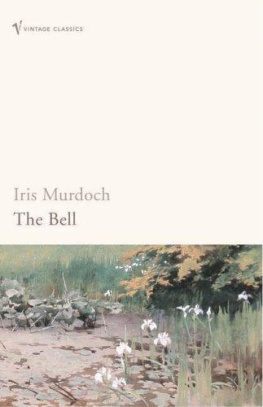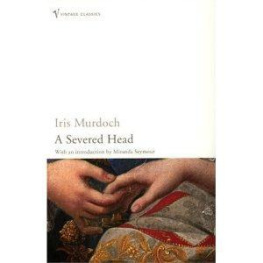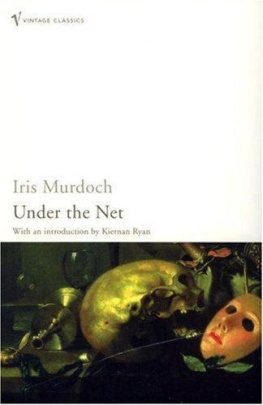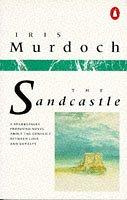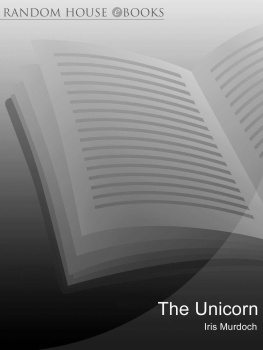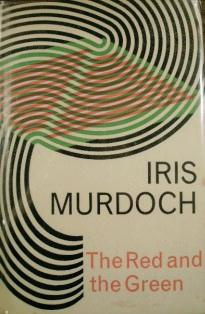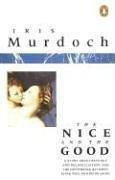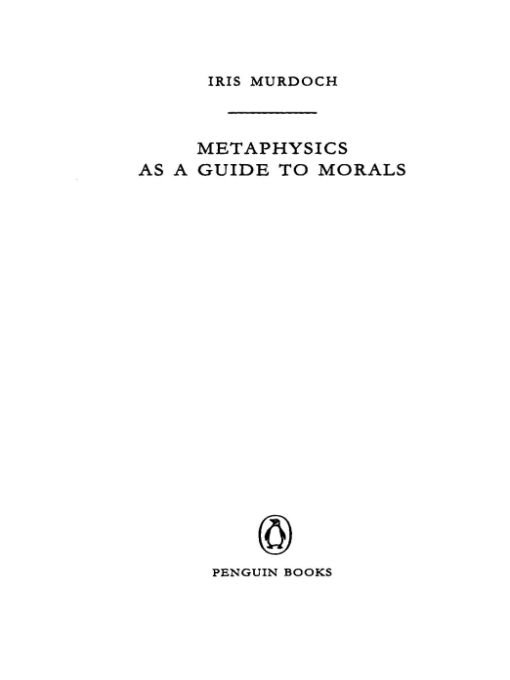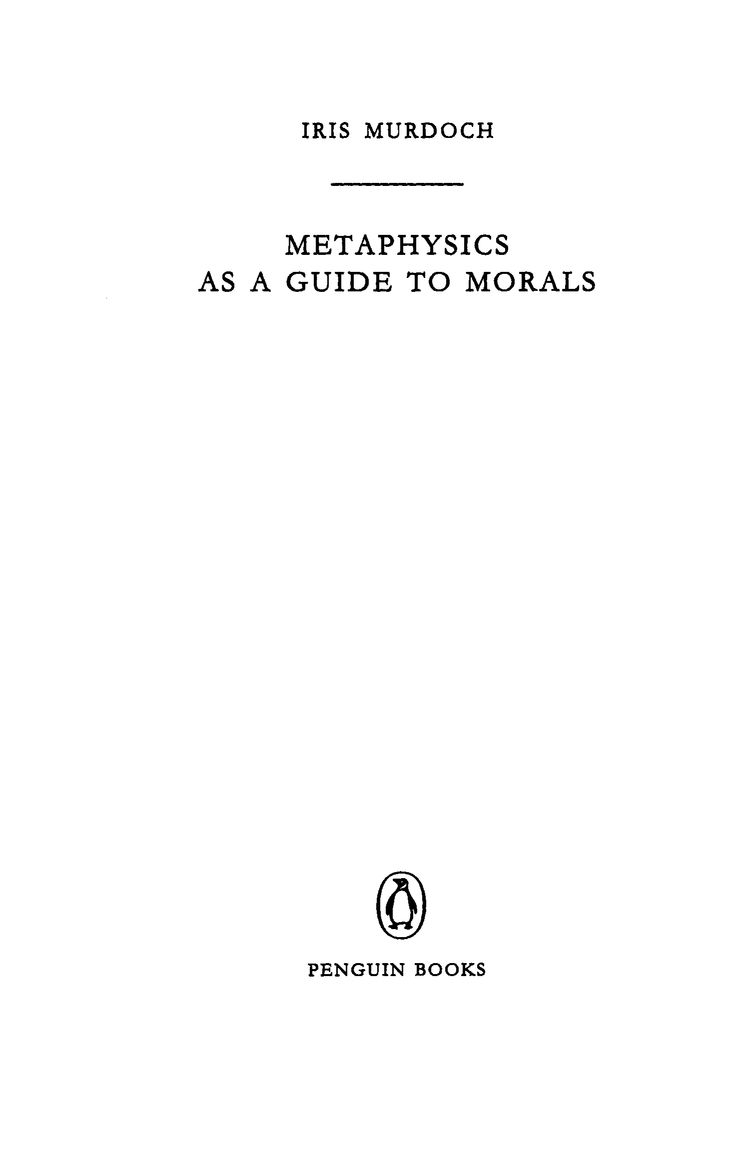Table of Contents
PENGUIN BOOKS
METAPHYSICS AS A GUIDE TO MORALS
Metaphysics as a Guide to Morals is a prodigious roller-coaster of a book, a journey through philosophy, religion, literature, art less a guide than a gigantic survey, a mapping, providing readers with the means to find their own ways ... I know of no other writer who could have covered such large areas with such authority, nor had the courage to treat fashion with such disdain
Nicholas Mosley in the Daily Telegraph
Physic is medicine and Iris Murdoch offers good medicine ... Her book is lively, witty and spell-binding, written by a sleuth on the trail of the meaning of Life
Peter Mullen in the Daily Mail
A large, elaborate and visionary philosophical essay ... richly stimulating ... this is a significant book, lambent with insights, intelligence, and profound concern
A. C. Grayling in the Financial Times
Metaphysics as a Guide to Morals is really a much needed Guide to Life. Good is the reality of which God is the dream is a line of simple beauty, distilling philosophical insight into purest poetry
Josephine Hart in the Sunday Express
It is a great congested work, a foaming sourcebook, about life, imagination, tragedy, philosophy, morality, religion and art
Galen Strawson in the Independent on Sunday
ABOUT THE AUTHOR
Iris Murdoch was born in Dublin in 1919 of Anglo-Irish parents. She went to Badminton School, Bristol, and read classics at Somerville College, Oxford. During the war she was an Assistant Principal at the Treasury, and then worked with UNRRA in London, Belgium and Austria. She held a studentship in philosophy at Newnham College, Cambridge, and then in 1948 became a Fellow of St Annes College, Oxford, where she lived with her husband, the teacher and critic John Bayley Awarded the CBE in 1976, Iris Murdoch was made a DBE in the 1987 New Years Honours List. In the 1997 PEN Awards she received the Gold Pen for Distinguished Service to Literature.
Iris Murdoch wrote twenty-six novels, including Under the Net, her writing dbut of 1954, the Booker Prize-winning The Sea, the Sea (1978) and, more recently, The Green Knight (1993) and Jacksons Dilemma (1995). She received a number of other literary awards, among them the James Tait Black Memorial Prize for The Black Prince (1973) and the Whitbread Prize for The Sacred and Profane Love Machine (1974). Her works of philosophy include Sartre: Romantic Rationalist, Metaphysics As a Guide to Morals (1992) and Existentialists and Mystics (1997). She also wrote several plays, including The Italian Girl (with James Saunders) and The Black Prince, an adaptation of her novel. Her volume of poetry, A Year of Birds, which appeared in 1978, was set to music by Malcolm Williamson.
Iris Murdoch died in February 1999. Among the many who paid tribute to her as a philosopher, novelist and private individual was Peter Conradi, who in his obituary in the Guardian wrote Iris Murdoch was one of the best and most influential writers of the twentieth century. Above all, she kept the traditional novel alive, and in so doing changed what it is capable of ... She connected goodness, against the temper of the times, not with the quest for an authentic identity so much as with the happiness that can come about when that quest is relaxed. We are fortunate to have shared our appalling century with her.
To
Elizabeth Anscombe
Une difficult est une lumire.
Une difficult insurmontable est un soleil.
PAUL VALRY
Conceptions of Unity. Art
The idea of a self-contained unity or limited whole is a fundamental instinctive concept. We see parts of things, we intuit whole things. We seem to know a great deal on the basis of very little. Oblivious of philosophical problems and paucity of evidence we grasp ourselves as unities, continuous bodies and continuous minds. We assume the continuity of space and time. This intuitive extension of our claim to knowledge has inspired the reflections of many philosophers. Hume, who was sceptical about this universal tendency, was prepared to say that some of our most cherished unities, the self, the material object, were illusions fostered by imagination, by association of ideas, by habit and custom. He admitted that the notion was repugnant to common-sense, not easily entertained outside the philosophers study even by the philosopher. On the other hand, the strength of our resistance was an aspect, even a proof, of the thing itself; continuous experience provides an orderly world and there is no need for us laymen to worry about deep foundations. Hume combined a radical scepticism with a benignly tolerant worldly wisdom. If a fiction is necessary enough, it is not a lie. Kant was upset by Humes account. He thought that it undermined scientific thinking and the theoretical and moral claims of human reason. Psychological associations and habits could not constitute the bases of our existence, something deeper and more radically necessary was required. We could not infer reality from experience when the possibility of experience itself needed to be explained. The urge to prove that where we intuit unity there really is unity is a deep emotional motive to philosophy, to art, to thinking itself. Intellect is naturally one-making. To evaluate, understand, classify, place in order of merit, implies a wider unified system, the questing mind abhors vacuums. We fear plurality, diffusion, senseless accident, chaos, we want to transform what we cannot dominate or understand into something reassuring and familiar,. into ordinary being, into history, art, religion, science. This subject or problem interests us now because the pluralisation or demythologisation of history, art, religion, science, which is characteristic of our age, largely takes the form of an analysis of old and prized unities and deep instinctive beliefs thought to be essential to human nature. Wittgenstein says that philosophy leaves everything as it is ... Philosophy simply puts everything before us, and neither explains nor deduces anything. (Philosophical Investigations 124, 126.) This degree of moderation is unusual. A physicist may succeed in reassuring us that his discoveries do not in any way discredit ordinary beliefs. But philosophers do usually intend to persuade us of something, and this is true at times of Wittgenstein too. Philosophy and science and theology have always been to some degree iconoclastic, and the everyday outlook or natural standpoint undergoes historical change. How much it changes many voices now tell us, how little it changes can be learnt from reading Homer. Where philosophy is concerned this change has taken place in a perspective (against a horizon) which goes back as far as the Greeks. We are now being told (for instance by Nietzsche, Heidegger, Derrida) that this horizon has been, to use Nietzsches phrase, sponged away, and that the era, not only of Descartes, but also of Plato, has ended and some entirely new mode of thinking is coming to be. I wish in what follows to study this situation, first of all in relation to the concept of the work of art.
The concept of art object or work of art has a force which goes far beyond what we usually think of as art. All sorts of things have aesthetic aspects, but what I have in mind is the traditional concept (now under attack) of the unified work of art. A work of art is of course not a material object, though some works of art are bodied forth by material objects so as to seem to inhere in them. In the case of a statue the relation between the material object and the art object seems close, in the case of a picture less so. Poems and symphonies are clearly not material objects. Works of art require material objects to keep them continuously available (our memories fade) and some require performance by secondary artists. All art objects are performed or imagined first by the artist and then by his clients, and these imaginative and intellectual activities or experiences may be said to be the point or essence of art. In ordinary life, unshadowed by philosophy, all sorts of things are said to exist in the mind or only in the mind, and there may be various bases and explanations of such phrases. Art, however, essentially (traditionally) involves the idea of a sustained


